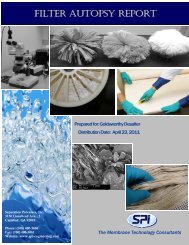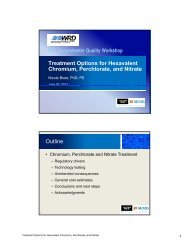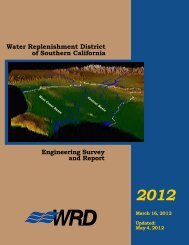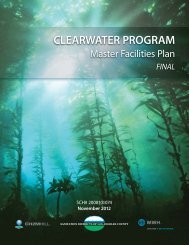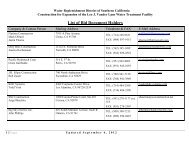Kevin Ryan GWRMP Coordinator USEPA Region 9 (415) 972‐3806 ryan.kevin@epa.gov
UCMR3 Groundwater Representative Monitoring Plans
UCMR3 Groundwater Representative Monitoring Plans
- No tags were found...
Create successful ePaper yourself
Turn your PDF publications into a flip-book with our unique Google optimized e-Paper software.
<strong>Kevin</strong> <strong>Ryan</strong><br />
<strong>GWRMP</strong> <strong>Coordinator</strong><br />
<strong>USEPA</strong> <strong>Region</strong> 9<br />
(<strong>415</strong>) <strong>972‐3806</strong><br />
<strong>ryan</strong>.<strong>kevin@epa</strong>.<strong>gov</strong>
“ A speech is a solemn<br />
responsibility. The man who<br />
makes a bad 30-minute speech to<br />
200 hundred people p wastes only a<br />
half-hour of his own time. But he<br />
wastes 100 hours of the<br />
audience’s time- more than 4 days<br />
– which should be a hanging<br />
offense. ”<br />
- Jenkin Lloyd Jones<br />
2
On 3/27/12 EPA Proposed Limits<br />
on Greenhouse‐Gas Emissions<br />
3
Oops, Wrong<br />
Speech/Presentation!<br />
4
<strong>GWRMP</strong> – Why do one?<br />
How do I do it, or more<br />
importantly, what does EPA want?<br />
5
Why? Budget Issues.<br />
• Monitoring every source is costly<br />
• UCMR3 allows UCMR2 approved<br />
<strong>GWRMP</strong>s; so<br />
• Possible savings for UCMR4?<br />
• Comment on proposed rules ‐<br />
get involved!<br />
6
How – Components of a <strong>GWRMP</strong><br />
• One plan for entire water system, including<br />
all proposed groundwater representative<br />
sampling locations (GWRSLs)<br />
• Or one plan for each proposed GWRSL<br />
• Plan has 4 sections; so<br />
• What are you responsible for?<br />
7
4 Sections of a <strong>GWRMP</strong><br />
• Section 1 ‐ Site Map<br />
9
Section 1 – Site Map<br />
• Location of all wells and EPTDS and the GWRSL<br />
• Geographical features & potential sources of<br />
contamination<br />
i<br />
• Scale and distances of each well from the proposed<br />
GWRSL<br />
• Illustrate basic information ( # of wells, screened intervals,<br />
aquifer characteristics/confining units, GW directional<br />
flow, time of travel)<br />
10
Section 2 – Contamination<br />
Susceptibility of Proposed Area<br />
State Groundwater Contamination i Information<br />
11
Section 2 – Contamination<br />
Susceptibility of Proposed Area<br />
• Identification of proposed sources of contamination: for<br />
the proposed GWRSL to be truly representative of the<br />
area, each well should have an equal possibility of<br />
contamination<br />
• Include a susceptibility analysis of the GWRSL(s) and<br />
other wells to the most significant source of contamination<br />
& TOT from the source of contamination<br />
• Summary of source water assessment plans or wellhead<br />
protection plans<br />
• If available, known GW contamination information<br />
should be included<br />
12
Section 3 – Similarities of GW Quality for<br />
Proposed Area<br />
Example State Groundwater Source Map<br />
13
Section 3 – Similarities of GW Quality<br />
for Proposed Area<br />
• Summary of well log information, well depth, construction<br />
methods (casings & grouting) and strata<br />
• Summary and analysis of H2O quality, including relevant<br />
parameters (historical and representative data) for each<br />
well and the GWRSL over a period of a year<br />
• Well pumping rates (important!)<br />
• GW source maps showing type of aquifer(s), well depths<br />
and IOCs<br />
• Use tables and graphs to illustrate, not raw data<br />
14
Section 4 – Summary of Proposal<br />
• Concise summary of why the specified GWRSL should be<br />
permitted<br />
• The <strong>GWRMP</strong> should demonstrate any GWRSL selected is<br />
representative of a well(s), draws from the same aquifer,<br />
and meets all relevant H2O quality parameters<br />
• Proposals that just include data in other sections without<br />
any analysis will be rejected<br />
• Questions on Proposals? Next section, EPA<br />
Review<br />
15
Section 8? – EPA’s Review (3) (i)<br />
Core Elements<br />
Section 141.35 (3) (i)<br />
PWSs may sample at<br />
Representative EPTDS if<br />
• They use ground water as a source<br />
• All of their well sources have either the same treatment or no<br />
treatment; and<br />
• They have multiple EPTDSs from the same source, such as an<br />
aquifer<br />
16
Section 8 – EPA’s Review - Continued<br />
Section 141.35 (3) (ii)<br />
• Applicability<br />
• Justification<br />
• Location Details<br />
• Wll Well Documentation<br />
ti<br />
• Homogeneity<br />
• Geography<br />
• Contamination Risk<br />
17
Section 8 – EPA’s Review - Continued<br />
Some Key Issues<br />
• Final Rule language changed from Proposed Rule: Proposed Rule<br />
stated the representative well must be one of the higher annual<br />
volume producing and consistently active wells; Final Rule stated “h “the<br />
proposed well must be representative of the highest annual volume<br />
producing and most consistently active wells in the representative<br />
array…”<br />
• Exception to the Rule: if that representative well is not in service at<br />
sampling time, select and sample an alternative representative well<br />
• Importance of selecting a consistently active well, is to minimize the<br />
chance that it will be out of service come sampling time<br />
• Previously approved UCMR2 <strong>GWRMP</strong>s don’t have to contain the<br />
highest producing and most active well –they just have to be<br />
representative of them (see why I call the review a Section 8?)<br />
18
Section 8 – EPA’s Review - Continued<br />
Key Issues<br />
• Previously approved UCMR2 <strong>GWRMP</strong>s have their<br />
sampling location information i pre‐loaded d into SDWARS<br />
and PWSs must review and confirm or update this data by<br />
October 1, 2012 (note: this date the UCMR3 database<br />
becomes locked)<br />
19
Section 8 – EPA’s Review - Continued<br />
Section 141.35 (3) (ii)<br />
• Applicability<br />
• Justification<br />
• Location Details –within 0.5 mile radius or 5‐year TOT<br />
• Wll Well Documentation<br />
ti<br />
• Homogeneity –e.g. pH, dissolved O2,conductivity, Fe, Mn<br />
• Geography<br />
• Contamination Risk – justification of no actual or<br />
potential occurrence or non‐occurrence of contaminants<br />
in the GWRSL or any of the wells represented<br />
20
Section 8 – EPA’s Review - Continued<br />
Section 141.35 (3) (ii)<br />
• Contamination Risk (cont.) –at a minimum, no greater<br />
or lesser risk ik of actual or potential il contaminant<br />
occurrence in the GWRSL or any of the representative<br />
wells<br />
• A PWS may not choose to omit a GW location with known<br />
or suspected contamination or select a GWRSL known to<br />
be free of contamination (within the array)<br />
• How ‐ a simple declaration or may include full source<br />
water vulnerability assessment with detailed drawings or<br />
maps<br />
21
Section 8 – EPA’s Review - Continued<br />
Section 141.35 (3) (ii)<br />
• Clear as Mud?<br />
22




